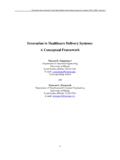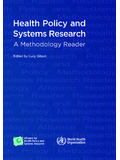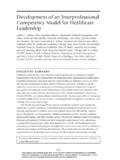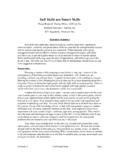Transcription of Patients’ perceptions of a home telecare system
1 International journal of medical informatics 77(2008)486 498journal homepage: perceptions of a home telecare systemMohammadreza Rahimpoura, Nigel H. Lovella,d, , Branko G. Cellerc, John McCormickbaGraduate School of Biomedical Engineering, University of New South Wales, Sydney, NSW 2052, AustraliabSchool of Education, University of New South Wales, Sydney, NSW 2052, AustraliacSchool of Electrical Engineering and Telecommunications, University of New South Wales, Sydney, NSW 2052, AustraliadNational Information and Communications Technology Australia (NICTA), Eveleigh, NSW 1430, Australiaarticle infoArticle history:Received 2 April 2007 Received in revised form7 October 2007 Accepted 8 October 2007 Keywords: home telecarePerceptionAcceptanceSelf-efficac yTechnophobiaAgeingChronic diseaseabstractGoal:To identify any major factors that could affect patients perceptions of a home Tele-care Management system (HTMS) and use the findings to contribute to development of atheoretical framework for patient acceptance of and methods:Ten Focus Group Interviews (FGIs) were conducted with patients suf-fering from congestive heart failure (CHF), chronic obstructive pulmonary disease (COPD),or both, from seven different ethnic groups in Sydney.
2 Six key discussion points were usedto conduct the FGIs. The participants were shown a video demonstrating the HTMS andits operation, followed by the demonstration of an HTMS prototype. The participants, whohad no prior experience with the HTMS, were then asked questions to access their percep-tions in potentially real situations. The discussions were audio-taped and content :Four major themes and 16 sub-themes were identified. The themes were: inten-tion to use the HTMS, the impact of the HTMS on patients health management, concernsassociated with using the HTMS, and the impact of the HTMS on healthcare :Most participants perceived the system as a useful and convenient mode ofhealth care delivery, expressed positive attitudes toward the HTMS and expressed intent touse the system . However, there were concerns centred on the issues of cost, ease of use, clin-ical support, low self-efficacy and anxiety related to the use of the HTMS.
3 The findings of thisstudy suggest that HTMS self-efficacy and anxiety are likely to be important constructs inpatients acceptance of home telecare . Therefore, we propose these two factors be includedin future HTMS acceptance models. Also it is suggested that in order to develop training pro-grams for patients to use HTMS, tailored training components should aim to reduce HTMS anxiety and improve HTMS self-efficacy . Participants agreed that the HTMS would savecost and time by reducing hospital admissions, emergency department and medical practi-tioner visits and associated travel. Participants generally agreed that the HTMS could informpatients of their health conditions, thus promoting active participation in their health man-agement and empowering them to perform better self-care. Also, they agreed that the HTMS could improve their health management by their doctors by providing more accurate andup-to-date information, to help them make better decisions.
4 They suggested that the HTMS could have a preventative role in terms of providing early warning when their health condi-tions were deteriorating, which could lead to on-time appropriate interventions. The lattermay result in reducing the use of emergency services and hospital Copyright 2007 Published by Elsevier Ireland Ltd. All rights reserved. Corresponding author. Tel.: +61 2 9385 3902; fax: +61 2 9663 Lovell).1386-5056/$ see front matter. Crown Copyright 2007 Published by Elsevier Ireland Ltd. All rights journal of medical informatics 77(2008)486 of a home telecare Management system (HTMS)[1,2]may be associated with user resistance. Thismay be particularly important when technical innovation isapplied to managing chronic healthcare in elderly patientswho are unaccustomed to modern technology. patients perceptions of home telecare are likely to influence itsacceptability[3,4].
5 Ignoring the human side of such a tech-nology innovation may limit its usefulness and delay properdecision-making. Therefore, the study of patients percep-tions can contribute to the eventual success of the this trial a pre-production prototype of a HTMS thatis now manufactured by MedCare Systems Pty. Ltd. (Syd-ney, NSW, Australia) was used. The HTMS was designedto record clinical indicators of a patient s health sta-tus and to provide feedback to patients including med-ication reminders and measurement scheduling[2].Itincorporated an extensive suite of clinical measurementsincluding a wireless weight scale, single lead electro-cardiogram, blood pressure cuff, spirometer, temperatureprobe, and pulse oximeter. A comprehensive suite of Web-enabled tools facilitated patient management by the published studies of subjective aspects oftelemedicine applications have investigated patients /providers satisfaction/perceptionafterreceivingtel emedicine services[3 12].
6 Most studies have attemptedto explore how patients rate specific aspects of telemedicineservices. Finkelstein et al.[9]in a randomised case controlstudy reported that all subjects (congestive heart failure,chronic obstructive pulmonary disease, and chronic wound-care patients ) were satisfied with their standard home healthcare and their satisfaction increased with an increasing levelof home telecare intervention. Chumbler et al.[7]in a casecontrol study compared health related outcomes of frailelders who received home teleheatlh and those who receivedno intervention. They reported that the majority of 111 olderpatients, who received home telehealth intervention feltmore secure, found the system easy to use and helpful inmanaging their chronic illnesses (hypertension, diabetes,heart disease, and respiratory disease). Demiris et al.[8]explored the perceptions of seniors in regard to smart home technology installed and operated in their homes by con-ducting three focus groups.
7 Although, they reported overallpositive attitude towards devices and sensors, concerns wereexpressed about the user-friendliness of the devices, lack ofhuman response and the need for tailoring the training toolder qualitative methods, Agrell et al.[13], Finkelsteinet al.[14], Mair et al.[15], and Whitten et al.[16,17]studiedpatients perceptions of home telenursing after experiencingthe system . Generally, they found that patients perceptionswere positive. Demiris et al.[18], in a case controlled trial,studied elderly patients perceptions of home telecare usinga questionnaire. patients were assessed both before and afterusing the system . The results indicated that the experimen-tal group generally expressed more positive perceptions afterexperiencing the system than the control group. Brignell etal.[19]recently reviewed the existing literature to identifystrategies for application of telemedicine in geriatric medi-cal practice, who concluded that there is evidence to suggestthat a number of telemedicine systems can be applied effec-tively in geriatric medicine.
8 They also pointed out that patientsatisfaction has been generally reported as high, and advisedcaution in this regard due to the insufficient number of robuststudies in the is worth noting that previous studies about patients per-ceptions of home telecare have used different technologicalapproaches that tended to be based around home telenursingand/or teleconsultation using video conferencing[5,4,13 16].However, the technology used in the HTMS involves activemanagement strategies, including scheduling patient mea-surements and conceptualisations of patients perceptions ofhome telecare have been introduced by different investiga-tors[13,4,17]. Since the HTMS is not the same type of hometelecare used in previous studies, there are factors identi-fied in these studies, which were considered inappropriatefor inclusion in this study unless some modifications wereconsidered.
9 For example, the HTMS does not include telecon-sultation, therefore, video consideration [13], factors relatedto the conduct of a virtual visit [4]and patients views ofthe implications of telenursing for their healthcare [17]cat-egories are not applicable in this study. Likewise, physicalpresence considerations [13], which referred to the impactof home telecare on physical presence of the medical prac-titioner or other medical staff (a health care worker) and itsrelationship with patients satisfaction and patients percep-tions of communications issues [17]are not relevant to was theorised that patients perceptions of the HTMS could be categorised as shown inTable 1. Since it was intendedto propose a model for patients acceptance of the HTMS[20]based on the Technology Acceptance Model (TAM) of Davis[21,22], TAM factors were incorporated into the response to the paucity of robust qualitative studies ofpatients perceptions of HTMS, an important and new aspectof the study is its integration of TAM in the research design(conceptual framework).
10 Indeed, we consider a comprehen-sive protocol, such as we used in this study to be vital forinvestigation of patients perceptions of TAM introduced by Davis[22]has been well-researchedin the area of information systems over nearly two decadesand supported by many studies. There is evidence that theTAM has been successful in predicting usage across a vari-ety of new technologies[23 26]. The TAM provides a generalexplanation of the determinants of computer acceptance andexplains computer usage behaviour in a wide range of com-puter user the TAM, user acceptance is evaluated by assess-ing users beliefs, attitudes, intentions, and actual usagebehaviour. As shown inFig. 1, according to the TAM, a user sattitude toward using the system is a major determinant ofwhether or not he or she actually uses it. Attitude (A) is definedas positive or negative feelings toward the information tech-nology (IT).



